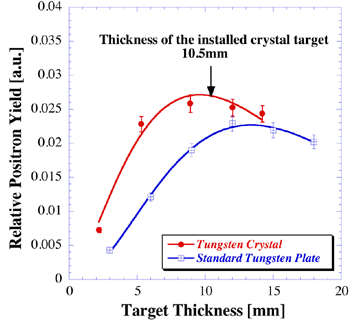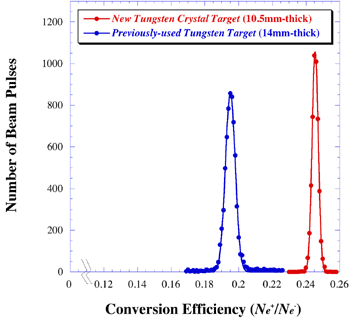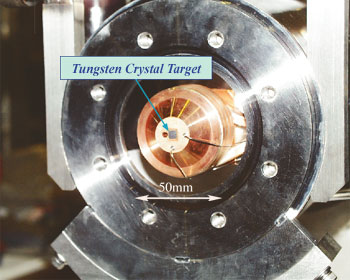Positrons are anti-particles of electrons. At KEK "B-Factory" (KEKB), they are produced copiously, and smashed into electrons at the world record luminosity, the rate of electron and positron collisions. By studying the hundreds of different decay patterns of B mesons and anti B mesons in these collisions, physicists look into the secrets of matter and antimatter imbalance and traces of other exotic particles. To improve the collision rate, developing a powerful positron source is one of the key element in this experiment.
A team led by Dr. Tsuyoshi Suwada of KEK successfully installed new type of positron source into the KEKB electron/positron injector linac. "The idea is to use a single crystal target of tungsten for the positron source," says Suwada. "This idea was first proposed by R. Chehab and his colleagues at LAL-Orsay in 1989. It was also experimented successfully at KEK and CERN (French-Russian collaboration). It turns out that an electron beam at small incidence along the rows of an aligned crystal, radiates a large number of photons due to channeling radiation and coherent bremsstrahlung."
"Interestingly, what we found in both experiments at KEK and CERN is that the positron yields get better as we increase the energy of the incident electron beam. At 4 GeV, 10.5 mm thick single crystal tungsten yields most positron (fig.1), a 25% increase compared to the standard tungsten target of 14 mm (fig 2)." Applied into the KEKB injection linac, enhanced yield of positrons helped the B-factory to improve its world record luminosity.
The tungsten crystals were developed at collaborating Tomsk POLYTECHNIC University. The crystal's axis < 111 > must be precisely oriented to the incident beam, and various technological issues were studied at KEK to mount the crystal into the beamline (fig. 3). "The key to the success is the precise alignment of the single crystal axis, and we found the Bragg-reflection of X-ray well suited for this purpose," added Suwada.
Useful information is about the stability and radiation damage of the crystal target expected to be obtained at the KEKB injector linac in its longer term operation. "We believe that this new method could be applied in the next generation of B-factories and e+e- linear colliders," Suwada concluded.
This work has been done through the collaborative efforts of Tokyo Metropolitan University, Kyushu Synchrotron Light Research Center, Tomsk POLYTECHNIC University, LAL-Orsay, and KEK.
[ Media Contact ] Youhei Morita, KEK Public Relations Office
+81 29-879-6047
|
 |
| Figure 1 : Variations of the relative positron yield as a function of the target thickness obtained at the test experiment. The incident electron energy and the measured positron momentum were 4 GeV and 20 MeV/c, respectively. |
 |
| Figure 2 : Electron-to-positron conversion efficiencies measured for each pulse at the positron capture section. The mean conversion efficiency for the new crystal target increased by about 25% in comparison with the previous conventional tungsten target. |
 |
| Figure 3 : Target assembly seen from downstream. The tungsten crystal with dimensions 5 mm x 5 mm, and a thickness of 10.5 mm is fixed to the cylindrical copper body for water cooling with a hot isostatic pressing technique. |
|



